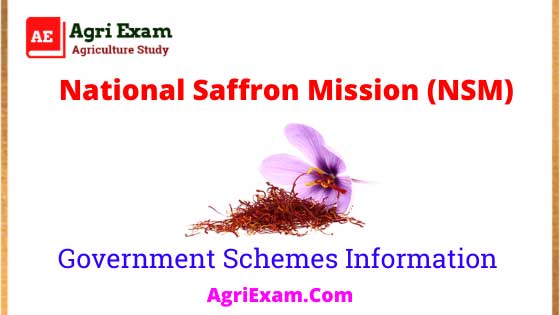National Saffron Mission (NSM) 2020

Introduction:
In 2011 Government of India Starts National Saffron mission with 400 crore but it fails to achieve its objective.
In 2020 Government revive National Saffron Mission again with the objective to Expand Saffron bowl of India From Jammu Kashmir to the North East.
NECTAR (North East Centre For Technology Application and Reach undertakes a pilot project to explore feasibility of growing saffron in North East region.
ISSUE:
Similarity of climatic and geographical conditions between Pampore area of Jammu&Kashmir and Yangyang area of Sikkim leads to successful sample farming of Saffron in Yangyang Started.
Crocus Sativus (saffron) is a legendary spice of Jammu Kashmir.
Initiative for economic revival of J&K Saffron under National Mission on Saffron under RKVY was introduced during 2010-11.
An area of Cof saffron was proposed to be rejuvenated under the mission.
SAFFRON PRODUCTION
- Jammu and Kashmir State had been under threat of extinction of Saffron as is evident from its dwindling share in global production.
PRODUCTION PRACTICES
- The production system previously followed in J&K was the main constraint responsible for the lower productivity of Saffron.
In lran and Spain, Pluriannual method of cultivation.
- Under which Saffron plants are left in the soil for two years continuous , after which corms are removed from the field for fresh plantation .
- Graded corms weighing above 8 gm are preferred fornew plantations.
Corms are irrigated during the months of September to October using sprinkler technology which ensures timely corm sprouting good flower yields and Increase Yield.
WHY SAFFRON MISSION ?
- Low productivity of saffron (1.88 Kg/ha).
- Orthodox cultivation methods.
Biotic and abiotic stresses
- Poor plant stand.
- Change in weather pattern over the years.
- lssues of adulteration and admixture.
OBJECTIVES OF SAFFRON MISSION
- Rejuvenation/replanting of existing Saffron area for improving productivity.
- lmproving soil health.
- Standardization of quality corm production in public nurseries
- Strengthening the irrigation system.
- Mechanization.
- Establishment of weather stations.
- Saffron growers recorded net increase in productivity from 1.800 Kgs/ha to 5.00 Kgs/ha in rejuvenated Saffron area under National Mission on Saffron.
COMPONENTS:
- Rejuvenation/Replanting of existing saffron area for improving productivity (75% GOI SHARE).
- Support for creation of irrigation facilities. GOI SHARE 100% (Tube wells & their harnessing).
- Production of planting Material (Public Sector Nurseries) 100% GOI SHARE.
- Enhancing product quality through improved post harvest handling 50% GOI SHARE.
- Mechanization 50% GOI SHARE.
Infrastructure development of public farms .GOI SHARE 100% .
- 16 public farms .GOI SHARE 100%.
- Weather Station/etrading/spot exchange/Quality testing/and ISO certification 100% GOI SHARE.
- Transfer of technologies and Human Resource Development (HRD)100% GOI SHARE.
SAFFRON BOWL IN NORTH EAST:
- The saffron bowl, which was so far confined to Kashmir, may soon expand to the North East of India.
- Plants from seeds transported from Kashmir to Sikkim and acclimatized there are now flowering in Yangyang in the Southern part of the North-East state.
- Saffron production has long been restricted to a limited geographical area in the Union territory of Jammu & Kashmir.
Pampore region, in j&k India, commonly known as Saffron bowl of Kashmir.
PILOT PROJECT
- North East Centre For Technology Application and Reach (NECTAR), an autonomous body under the Department of Science & Technology.
It has supported a pilot project to explore the feasibility of growing saffron in North East region of India, with the same quality and higher quantity.
- The Botany & Horticulture departments of Sikkim Central University carried out tests to understand the soil and actual pH conditions of Yangyang area of Sikkim.
- They found it comparable to saffron growing places of Kashmir.
- Saffron seed/corms were purchased & air transported from Kashmir to Yangyang(Sikkim) site by the department.
The corms were irrigated during the month of September to October, which ensures timely corm sprouting & good flower yields.
- The project also focused on post-harvest management & value addition of saffron Under these mission.
- Quality saffron drying and efficient post-harvest processing of saffron can improve saffron recovery rate, thereby improving its production.
Q.1 Leading Producer of saffron in India?
- J&k
- Sikkim
- Punjab
- Karnataka
Q.2 Legendary spice of Saffron in Jammu Kashmir?
Q.3 Full form of NECTOR?
Q.4 Under National Saffron Mission saffron Cultivation expand from J&k to?
Q.5 Saffron bowl of Kashmir?
Q.6 How much area to be rejuvenated under the mission?
| All Government Schemes | Click |
| Agriculture Study Material | Click |
Answer revealing TRANSITION effect is irritating.it gives no time to read the answers provided. and screen goes on shaking. hope you will rectify this